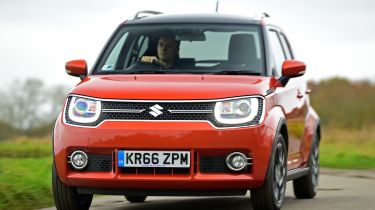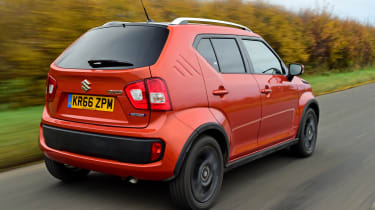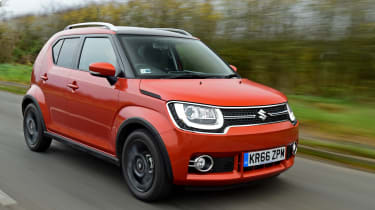New Suzuki Ignis 2017 review
The Suzuki Ignis name has been revived, but how does the quirky crossover city car perform on British roads?

The Ignis is a breath of fresh air in the city car class, with its distinctive crossover styling, bold details and light kerbweight. It’s also spacious and, despite not being as accomplished as the best choices in this market, it’s likeable to drive. We’d recommend shunning this compromised top-spec four-wheel-drive variant and settling for a cheaper front-wheel-drive SZ-T model, which looks set to offer great value for money.
Several car makers have revived defunct model names for new models over the past few years; just look at the Vauxhall Viva and Hyundai Tucson. Suzuki brought the Baleno name back to life earlier this year, and now the Japanese brand has done it again with the Ignis.
The Ignis badge was last seen on the back of a Suzuki nine years ago, but it has to be said that the high-riding supermini never really captured the imagination of the British public, and didn’t prove an especially big seller. Perhaps it was a few years ahead of its time, given that the market for baby SUVs has sky-rocketed over the past few years.
In any case, the car that carries the Ignis name in 2016 is altogether more interesting. It sits on Suzuki’s new small car platform, and as such, shares components with the Baleno and forthcoming next-generation Swift supermini. The Ignis is, in effect, a crossover city car in the vein of the Fiat Panda 4x4. Suzuki cites chic rivals such as the Fiat 500 and Vauxhall Adam Rocks, too, so the Ignis has to be as much about form as function.
Used - available now

2022 Fiat
500
22,532 milesManualPetrol1.0L
Cash £9,549
2023 Honda
Jazz
24,192 milesAutomaticPetrol1.5L
Cash £14,999
2022 Vauxhall
Corsa
30,379 milesManualPetrol1.2L
Cash £11,549
2022 MINI
5-Door Hatch
32,498 milesAutomaticPetrol1.5L
Cash £15,049At 3.7 metres long, it’s slightly bigger than a Hyundai i10, but with its cutesy front end, narrow upper body, angled roofline and chunky wheelarches, it’s one of the most distinctive small cars around. Love it or hate it – we happen to be in the former camp – but there’s no denying that the Ignis has a real personality that only a handful of rivals can replicate.
The inside of the car is a little more conventional, but it’s more upmarket than the stark surroundings of Suzuki’s other city car offering, the Celerio. Brightening things up is the two-tone finish for the dashboard and doors, while neat touches such as the glossy body-colour door pulls, tablet-style touchscreen and separate console for the climate controls give the Ignis’s cabin some character.
The SZ5 model driven here also comes loaded with kit, with sat-nav, LED headlights, dual-zone climate control and keyless entry all thrown in. It’s a pity the sat-nav and infotainment system is a fiddly aftermarket Pioneer set-up rather than Suzuki’s own (although that's expected to change at a later date), while the plastics on the dash and door trims are hard and fairly insubstantial. Still, everything does feel well screwed together enough.
You sit fairly upright in the Ignis, and the cabin is narrow, but there’s a surprising amount of leg and headroom throughout. That’s thanks to both the short dashboard and the two individual sliding and reclining rear seats that are offered on mid-spec SZ-T models and above. The Suzuki serves up more space than many city car competitors, and four adults would be comfortable enough on longer journeys.
The space is impressive, and given the Ignis’s light weight – it tips the scales at 810kg in its lightest form, depending on the spec you choose – it feels eager and agile on the road. All models get Suzuki’s willing 1.2-litre Dualjet four-cylinder petrol engine with 89bhp, but you can also add the 48-Volt SHVS mild hybrid system, as tested here.
The addition of electrical assistance helps to shave over two seconds from the 0-62mph sprint time, but the little Suzuki feels even quicker than those figures suggest, and it's happy to be revved out. The lack of a turbo option means that you'll be doing so quite often to get the best out of it, however. It does get a bit thrashy at high revs, though.
As you’d expect, the Ignis is fun to drive in town, thanks to the compact dimensions and good visibility. It’s a bit of a mixed bag once you get out on to the open road, however. On the one hand, the car feels nimble and the ride is cushioned and controlled at speed, but big bumps at low speeds can unsettle it, and wind, engine and road noise are all more evident than in a Volkswagen up! or Hyundai i10. Body roll is quite noticeable, too, and the steering is slow and vague when you begin to apply lock.
Our car was fitted with four-wheel drive, but the Ignis can’t really live up to its billing as a Panda 4x4 rival, because you don’t get any extra ground clearance. The system also eats into the boot space and reduces efficiency, so we’d expect a mid-spec front-wheel-drive variant to be a sweeter, better-value choice that could warrant a four-star rating.










